Tensorflow 实现 Transformer 模型将葡萄牙语翻译成英语

代码下载:https://github.com/wennaz/Deep_Learning
本例子是训练了一个 Transformer 模型 用于将葡萄牙语翻译成英语。这是一个高级示例,假定您具备文本生成(text generation)和 注意力机制(attention) 的知识。
Transformer 模型的核心思想是自注意力机制(self-attention)——能注意输入序列的不同位置以计算该序列的表示的能力。Transformer 创建了多层自注意力层(self-attetion layers)组成的堆栈,下文的按比缩放的点积注意力(Scaled dot product attention)和多头注意力(Multi-head attention)部分对此进行了说明。
一个 transformer 模型用自注意力层而非 RNNs 或 CNNs 来处理变长的输入。这种通用架构有一系列的优势:
它不对数据间的时间/空间关系做任何假设。这是处理一组对象(objects)的理想选择(例如,星际争霸单位(StarCraft units))。 层输出可以并行计算,而非像 RNN 这样的序列计算。 远距离项可以影响彼此的输出,而无需经过许多 RNN 步骤或卷积层(例如,参见场景记忆 Transformer(Scene Memory Transformer)) 它能学习长距离的依赖。在许多序列任务中,这是一项挑战。
该架构的缺点是:
对于时间序列,一个单位时间的输出是从整个历史记录计算的,而非仅从输入和当前的隐含状态计算得到。这可能效率较低。 如果输入确实有时间/空间的关系,像文本,则必须加入一些位置编码,否则模型将有效地看到一堆单词。 在此 notebook 中训练完模型后,您将能输入葡萄牙语句子,得到其英文翻译。
import tensorflow_datasets as tfdsimport tensorflow as tf
import timeimport numpy as npimport matplotlib.pyplot as plt# 使用 TFDS 来导入 葡萄牙语-英语翻译数据集,该数据集来自于 TED 演讲开放翻译项目.
print("start")# 该数据集包含来约 50000 条训练样本,1100 条验证样本,以及 2000 条测试样本。examples, metadata = tfds.load('ted_hrlr_translate/pt_to_en', with_info=True, as_supervised=True)train_examples, val_examples = examples['train'], examples['validation']
# 从训练数据集创建自定义子词分词器(subwords tokenizer)。tokenizer_en = tfds.deprecated.text.SubwordTextEncoder.build_from_corpus((en.numpy() for pt, en in train_examples), target_vocab_size=2**13)
tokenizer_pt = tfds.deprecated.text.SubwordTextEncoder.build_from_corpus((pt.numpy() for pt, en in train_examples), target_vocab_size=2**13)sample_string = 'Transformer is awesome.'
tokenized_string = tokenizer_en.encode(sample_string)print ('Tokenized string is {}'.format(tokenized_string))
original_string = tokenizer_en.decode(tokenized_string)print ('The original string: {}'.format(original_string))
assert original_string == sample_string
# 如果单词不在词典中,则分词器(tokenizer)通过将单词分解为子词来对字符串进行编码。for ts in tokenized_string: print ('{} ----> {}'.format(ts, tokenizer_en.decode([ts])))
BUFFER_SIZE = 20000BATCH_SIZE = 64
# 将开始和结束标记(token)添加到输入和目标。def encode(lang1, lang2): lang1 = [tokenizer_pt.vocab_size] + tokenizer_pt.encode(lang1.numpy()) + [tokenizer_pt.vocab_size+1]
lang2 = [tokenizer_en.vocab_size] + tokenizer_en.encode(lang2.numpy()) + [tokenizer_en.vocab_size+1] return lang1, lang2
# Note:为了使本示例较小且相对较快,删除长度大于40个标记的样本。MAX_LENGTH = 40def filter_max_length(x, y, max_length=MAX_LENGTH): return tf.logical_and(tf.size(x) <= max_length,tf.size(y) <= max_length)
# .map() 内部的操作以图模式(graph mode)运行,.map() 接收一个不具有 numpy 属性的图张量(graph tensor)。# 该分词器(tokenizer)需要将一个字符串或 Unicode 符号,编码成整数。# 因此,您需要在 tf.py_function 内部运行编码过程,tf.py_function 接收一个 eager 张量,# 该 eager 张量有一个包含字符串值的 numpy 属性。def tf_encode(pt, en): result_pt, result_en = tf.py_function(encode, [pt, en], [tf.int64, tf.int64]) result_pt.set_shape([None]) result_en.set_shape([None]) return result_pt, result_entrain_dataset = train_examples.map(tf_encode)train_dataset = train_dataset.filter(filter_max_length)# 将数据集缓存到内存中以加快读取速度。train_dataset = train_dataset.cache()train_dataset = train_dataset.shuffle(BUFFER_SIZE).padded_batch(BATCH_SIZE)train_dataset = train_dataset.prefetch(tf.data.experimental.AUTOTUNE)val_dataset = val_examples.map(tf_encode)val_dataset = val_dataset.filter(filter_max_length).padded_batch(BATCH_SIZE)pt_batch, en_batch = next(iter(val_dataset))pt_batch, en_batch
# 因为该模型并不包括任何的循环(recurrence)或卷积,所以模型添加了位置编码,为模型提供一些关于单词在句子中相对位置的信息。# 位置编码向量被加到嵌入(embedding)向量中。嵌入表示一个 d 维空间的标记,在 d 维空间中有着相似含义的标记会离彼此更近。# 但是,嵌入并没有对在一句话中的词的相对位置进行编码。# 因此,当加上位置编码后,词将基于它们含义的相似度以及它们在句子中的位置,在 d 维空间中离彼此更近。def get_angles(pos, i, d_model): angle_rates = 1 / np.power(10000, (2 * (i//2)) / np.float32(d_model)) return pos * angle_ratesdef positional_encoding(position, d_model): angle_rads = get_angles(np.arange(position)[:, np.newaxis],np.arange(d_model)[np.newaxis, :],d_model) # 将 sin 应用于数组中的偶数索引(indices);2i angle_rads[:, 0::2] = np.sin(angle_rads[:, 0::2]) # 将 cos 应用于数组中的奇数索引;2i+1 angle_rads[:, 1::2] = np.cos(angle_rads[:, 1::2]) pos_encoding = angle_rads[np.newaxis, ...] return tf.cast(pos_encoding, dtype=tf.float32)
pos_encoding = positional_encoding(50, 512)print (pos_encoding.shape)
plt.pcolormesh(pos_encoding[0], cmap='RdBu')plt.xlabel('Depth')plt.xlim((0, 512))plt.ylabel('Position')plt.colorbar()plt.show()
# 遮挡(Masking)# 遮挡一批序列中所有的填充标记(pad tokens)。# 这确保了模型不会将填充作为输入。该 mask 表明填充值 0 出现的位置:在这些位置 mask 输出 1,否则输出 0。def create_padding_mask(seq): seq = tf.cast(tf.math.equal(seq, 0), tf.float32) # 添加额外的维度来将填充加到 # 注意力对数(logits)。 return seq[:, tf.newaxis, tf.newaxis, :] # (batch_size, 1, 1, seq_len)
x = tf.constant([[7, 6, 0, 0, 1], [1, 2, 3, 0, 0], [0, 0, 0, 4, 5]])create_padding_mask(x)# 前瞻遮挡(look-ahead mask)用于遮挡一个序列中的后续标记(future tokens)。换句话说,该 mask 表明了不应该使用的条目。
# 这意味着要预测第三个词,将仅使用第一个和第二个词。与此类似,预测第四个词,仅使用第一个,第二个和第三个词,依此类推。def create_look_ahead_mask(size): mask = 1 - tf.linalg.band_part(tf.ones((size, size)), -1, 0) return mask # (seq_len, seq_len)
x = tf.random.uniform((1, 3))temp = create_look_ahead_mask(x.shape[1])temp
start
Tokenized string is [7915, 1248, 7946, 7194, 13, 2799, 7877]
The original string: Transformer is awesome.
7915 ----> T
1248 ----> ran
7946 ----> s
7194 ----> former
13 ----> is
2799 ----> awesome
7877 ----> .
(1, 50, 512)
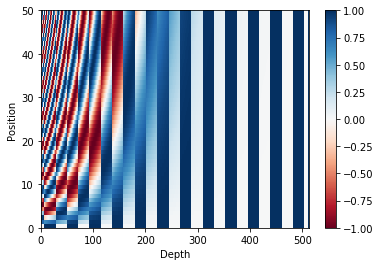
Output:
<tf.Tensor: shape=(3, 3), dtype=float32, numpy=array([[0., 1., 1.],[0., 0., 1.],[0., 0., 0.]], dtype=float32)>
按比缩放的点积注意力(Scaled dot product attention)
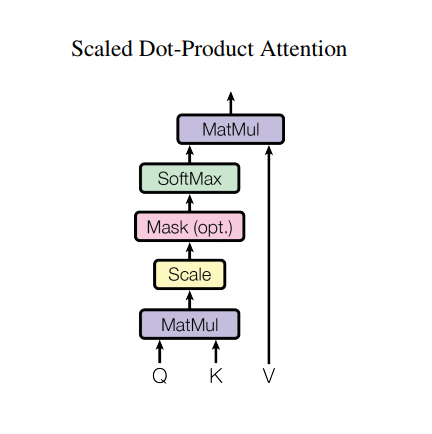
Transformer 使用的注意力函数有三个输入:Q(请求(query))、K(主键(key))、V(数值(value))
def scaled_dot_product_attention(q, k, v, mask):# """# 计算注意力权重。# q, k, v 必须具有匹配的前置维度。# k, v 必须有匹配的倒数第二个维度,例如:seq_len_k = seq_len_v。# 虽然 mask 根据其类型(填充或前瞻)有不同的形状,# 但是 mask 必须能进行广播转换以便求和。
# 参数:# q: 请求的形状 == (..., seq_len_q, depth)# k: 主键的形状 == (..., seq_len_k, depth)# v: 数值的形状 == (..., seq_len_v, depth_v)# mask: Float 张量,其形状能转换成# (..., seq_len_q, seq_len_k)。默认为None。
# 返回值:# 输出,注意力权重# """ matmul_qk = tf.matmul(q, k, transpose_b=True) # (..., seq_len_q, seq_len_k)
# 缩放 matmul_qk dk = tf.cast(tf.shape(k)[-1], tf.float32) scaled_attention_logits = matmul_qk / tf.math.sqrt(dk)
# 将 mask 加入到缩放的张量上。 if mask is not None: scaled_attention_logits += (mask * -1e9)
# softmax 在最后一个轴(seq_len_k)上归一化,因此分数 # 相加等于1。 attention_weights = tf.nn.softmax(scaled_attention_logits, axis=-1) # (..., seq_len_q, seq_len_k)
output = tf.matmul(attention_weights, v) # (..., seq_len_q, depth_v)
return output, attention_weights
# 当 softmax 在 K 上进行归一化后,它的值决定了分配到 Q 的重要程度。
# 输出表示注意力权重和 V(数值)向量的乘积。这确保了要关注的词保持原样,而无关的词将被清除掉。def print_out(q, k, v): temp_out, temp_attn = scaled_dot_product_attention(q, k, v, None) print ('Attention weights are:') print (temp_attn) print ('Output is:') print (temp_out) np.set_printoptions(suppress=True)
temp_k = tf.constant([[10,0,0], [0,10,0], [0,0,10], [0,0,10]], dtype=tf.float32) # (4, 3)
temp_v = tf.constant([[ 1,0], [ 10,0], [ 100,5], [1000,6]], dtype=tf.float32) # (4, 2)
# 这条 `请求(query)符合第二个`主键(key)`,# 因此返回了第二个`数值(value)`。temp_q = tf.constant([[0, 10, 0]], dtype=tf.float32) # (1, 3)print_out(temp_q, temp_k, temp_v)
# 这条请求符合重复出现的主键(第三第四个),# 因此,对所有的相关数值取了平均。temp_q = tf.constant([[0, 0, 10]], dtype=tf.float32) # (1, 3)print_out(temp_q, temp_k, temp_v)
temp_q = tf.constant([[0, 0, 10], [0, 10, 0], [10, 10, 0]], dtype=tf.float32) # (3, 3)print_out(temp_q, temp_k, temp_v)
Attention weights are:
tf.Tensor([[0. 1. 0. 0.]], shape=(1, 4), dtype=float32)
Output is:
tf.Tensor([[10. 0.]], shape=(1, 2), dtype=float32)
Attention weights are:tf.Tensor([[0. 0. 0.5 0.5]], shape=(1, 4), dtype=float32)
Output is:
tf.Tensor([[550. 5.5]], shape=(1, 2), dtype=float32)
Attention weights are:
tf.Tensor([[0. 0. 0.5 0.5][0. 1. 0. 0. ][0.5 0.5 0. 0. ]], shape=(3, 4), dtype=float32)
Output is:
tf.Tensor([[550. 5.5][ 10. 0. ][ 5.5 0. ]], shape=(3, 2), dtype=float32)
多头注意力(Multi-head attention)
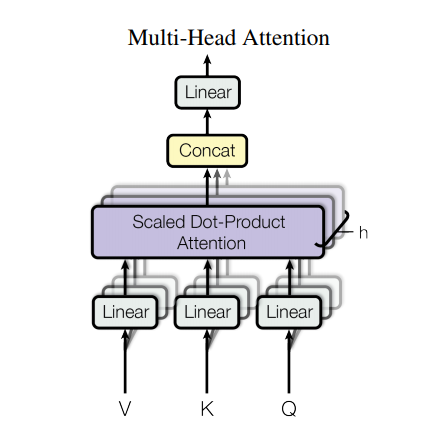
多头注意力由四部分组成:
线性层并分拆成多头。按比缩放的点积注意力。多头及联。最后一层线性层。每个多头注意力块有三个输入:Q(请求)、K(主键)、V(数值)。这些输入经过线性(Dense)层,并分拆成多头。
将上面定义的 scaled_dot_product_attention 函数应用于每个头(进行了广播(broadcasted)以提高效率)。注意力这步必须使用一个恰当的 mask。然后将每个头的注意力输出连接起来(用 tf.transpose 和 tf.reshape),并放入最后的 Dense 层。
Q、K、和 V 被拆分到了多个头,而非单个的注意力头,因为多头允许模型共同注意来自不同表示空间的不同位置的信息。在分拆后,每个头部的维度减少,因此总的计算成本与有着全部维度的单个注意力头相同。
class MultiHeadAttention(tf.keras.layers.Layer): def __init__(self, d_model, num_heads): super(MultiHeadAttention, self).__init__() self.num_heads = num_heads self.d_model = d_model
assert d_model % self.num_heads == 0
self.depth = d_model // self.num_heads
self.wq = tf.keras.layers.Dense(d_model) self.wk = tf.keras.layers.Dense(d_model) self.wv = tf.keras.layers.Dense(d_model)
self.dense = tf.keras.layers.Dense(d_model)
def split_heads(self, x, batch_size):# """分拆最后一个维度到 (num_heads, depth).# 转置结果使得形状为 (batch_size, num_heads, seq_len, depth)# """ x = tf.reshape(x, (batch_size, -1, self.num_heads, self.depth)) return tf.transpose(x, perm=[0, 2, 1, 3])
def call(self, v, k, q, mask): batch_size = tf.shape(q)[0]
q = self.wq(q) # (batch_size, seq_len, d_model) k = self.wk(k) # (batch_size, seq_len, d_model) v = self.wv(v) # (batch_size, seq_len, d_model)
q = self.split_heads(q, batch_size) # (batch_size, num_heads, seq_len_q, depth) k = self.split_heads(k, batch_size) # (batch_size, num_heads, seq_len_k, depth) v = self.split_heads(v, batch_size) # (batch_size, num_heads, seq_len_v, depth)
# scaled_attention.shape == (batch_size, num_heads, seq_len_q, depth) # attention_weights.shape == (batch_size, num_heads, seq_len_q, seq_len_k) scaled_attention, attention_weights = scaled_dot_product_attention(q, k, v, mask)
scaled_attention = tf.transpose(scaled_attention, perm=[0, 2, 1, 3]) # (batch_size, seq_len_q, num_heads, depth)
concat_attention = tf.reshape(scaled_attention, (batch_size, -1, self.d_model)) # (batch_size, seq_len_q, d_model)
output = self.dense(concat_attention) # (batch_size, seq_len_q, d_model)
return output, attention_weights # 创建一个 MultiHeadAttention 层进行尝试。# 在序列中的每个位置 y,MultiHeadAttention 在序列中的所有其他位置运行所有8个注意力头,# 在每个位置y,返回一个新的同样长度的向量。temp_mha = MultiHeadAttention(d_model=512, num_heads=8)y = tf.random.uniform((1, 60, 512)) # (batch_size, encoder_sequence, d_model)out, attn = temp_mha(y, k=y, q=y, mask=None)out.shape, attn.shape
# 点式前馈网络(Point wise feed forward network)# 点式前馈网络由两层全联接层组成,两层之间有一个 ReLU 激活函数。def point_wise_feed_forward_network(d_model, dff): return tf.keras.Sequential([ tf.keras.layers.Dense(dff, activation='relu'), # (batch_size, seq_len, dff) tf.keras.layers.Dense(d_model) # (batch_size, seq_len, d_model) ])sample_ffn = point_wise_feed_forward_network(512, 2048)sample_ffn(tf.random.uniform((64, 50, 512))).shape
Output:TensorShape([64, 50, 512])
编码与解码(Encoder and decoder)
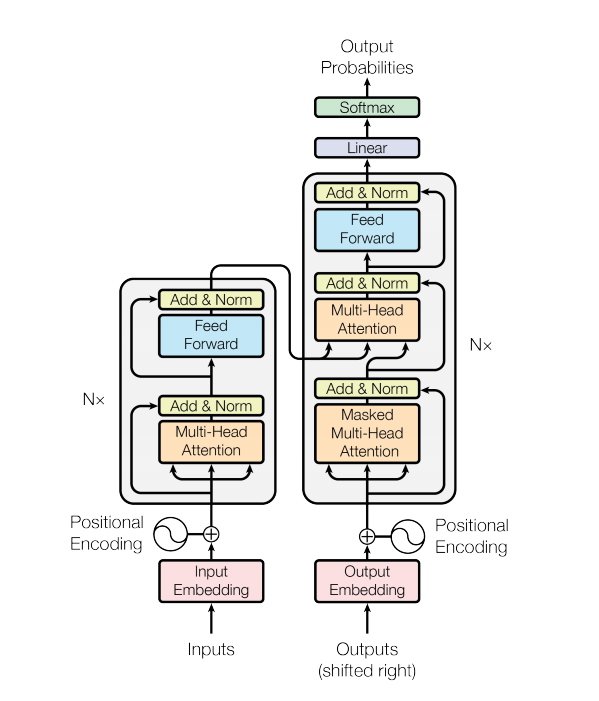
Transformer 模型与标准的具有注意力机制的序列到序列模型(sequence to sequence with attention model),遵循相同的一般模式。
输入语句经过 N 个编码器层,为序列中的每个词/标记生成一个输出。 解码器关注编码器的输出以及它自身的输入(自注意力)来预测下一个词。 编码器层(Encoder layer) 每个编码器层包括以下子层:
多头注意力(有填充遮挡) 点式前馈网络(Point wise feed forward networks)。 每个子层在其周围有一个残差连接,然后进行层归一化。残差连接有助于避免深度网络中的梯度消失问题。
每个子层的输出是 LayerNorm(x + Sublayer(x))。归一化是在 d_model(最后一个)维度完成的。Transformer 中有 N 个编码器层。
class EncoderLayer(tf.keras.layers.Layer): def __init__(self, d_model, num_heads, dff, rate=0.1): super(EncoderLayer, self).__init__()
self.mha = MultiHeadAttention(d_model, num_heads) self.ffn = point_wise_feed_forward_network(d_model, dff)
self.layernorm1 = tf.keras.layers.LayerNormalization(epsilon=1e-6) self.layernorm2 = tf.keras.layers.LayerNormalization(epsilon=1e-6)
self.dropout1 = tf.keras.layers.Dropout(rate) self.dropout2 = tf.keras.layers.Dropout(rate)
def call(self, x, training, mask):
attn_output, _ = self.mha(x, x, x, mask) # (batch_size, input_seq_len, d_model) attn_output = self.dropout1(attn_output, training=training) out1 = self.layernorm1(x + attn_output) # (batch_size, input_seq_len, d_model)
ffn_output = self.ffn(out1) # (batch_size, input_seq_len, d_model) ffn_output = self.dropout2(ffn_output, training=training) out2 = self.layernorm2(out1 + ffn_output) # (batch_size, input_seq_len, d_model) return out2
sample_encoder_layer = EncoderLayer(512, 8, 2048)
sample_encoder_layer_output = sample_encoder_layer(tf.random.uniform((64, 43, 512)), False, None)
sample_encoder_layer_output.shape # (batch_size, input_seq_len, d_model)
Output:TensorShape([64, 43, 512])
解码器层(Decoder layer)
每个解码器层包括以下子层:
遮挡的多头注意力(前瞻遮挡和填充遮挡) 多头注意力(用填充遮挡)。V(数值)和 K(主键)接收编码器输出作为输入。Q(请求)接收遮挡的多头注意力子层的输出。 点式前馈网络 每个子层在其周围有一个残差连接,然后进行层归一化。每个子层的输出是 LayerNorm(x + Sublayer(x))。归一化是在 d_model(最后一个)维度完成的。
Transformer 中共有 N 个解码器层。
当 Q 接收到解码器的第一个注意力块的输出,并且 K 接收到编码器的输出时,注意力权重表示根据编码器的输出赋予解码器输入的重要性。换一种说法,解码器通过查看编码器输出和对其自身输出的自注意力,预测下一个词。参看按比缩放的点积注意力部分的演示。
class DecoderLayer(tf.keras.layers.Layer): def __init__(self, d_model, num_heads, dff, rate=0.1): super(DecoderLayer, self).__init__()
self.mha1 = MultiHeadAttention(d_model, num_heads) self.mha2 = MultiHeadAttention(d_model, num_heads)
self.ffn = point_wise_feed_forward_network(d_model, dff)
self.layernorm1 = tf.keras.layers.LayerNormalization(epsilon=1e-6) self.layernorm2 = tf.keras.layers.LayerNormalization(epsilon=1e-6) self.layernorm3 = tf.keras.layers.LayerNormalization(epsilon=1e-6)
self.dropout1 = tf.keras.layers.Dropout(rate) self.dropout2 = tf.keras.layers.Dropout(rate) self.dropout3 = tf.keras.layers.Dropout(rate)
def call(self, x, enc_output, training, look_ahead_mask, padding_mask): # enc_output.shape == (batch_size, input_seq_len, d_model)
attn1, attn_weights_block1 = self.mha1(x, x, x, look_ahead_mask) # (batch_size, target_seq_len, d_model) attn1 = self.dropout1(attn1, training=training) out1 = self.layernorm1(attn1 + x)
attn2, attn_weights_block2 = self.mha2(enc_output, enc_output, out1, padding_mask) # (batch_size, target_seq_len, d_model) attn2 = self.dropout2(attn2, training=training) out2 = self.layernorm2(attn2 + out1) # (batch_size, target_seq_len, d_model)
ffn_output = self.ffn(out2) # (batch_size, target_seq_len, d_model) ffn_output = self.dropout3(ffn_output, training=training) out3 = self.layernorm3(ffn_output + out2) # (batch_size, target_seq_len, d_model)
return out3, attn_weights_block1, attn_weights_block2 sample_decoder_layer = DecoderLayer(512, 8, 2048)
sample_decoder_layer_output, _, _ = sample_decoder_layer(tf.random.uniform((64, 50, 512)), sample_encoder_layer_output, False, None, None)
sample_decoder_layer_output.shape # (batch_size, target_seq_len, d_model)
Output:TensorShape([64, 50, 512])
# 编码器(Encoder)# 编码器 包括:
# 输入嵌入(Input Embedding)# 位置编码(Positional Encoding)# N 个编码器层(encoder layers)# 输入经过嵌入(embedding)后,该嵌入与位置编码相加。该加法结果的输出是编码器层的输入。编码器的输出是解码器的输入。class Encoder(tf.keras.layers.Layer): def __init__(self, num_layers, d_model, num_heads, dff, input_vocab_size,maximum_position_encoding, rate=0.1): super(Encoder, self).__init__()
self.d_model = d_model self.num_layers = num_layers
self.embedding = tf.keras.layers.Embedding(input_vocab_size, d_model) self.pos_encoding = positional_encoding(maximum_position_encoding, self.d_model) self.enc_layers = [EncoderLayer(d_model, num_heads, dff, rate) for _ in range(num_layers)]
self.dropout = tf.keras.layers.Dropout(rate)
def call(self, x, training, mask): seq_len = tf.shape(x)[1]
# 将嵌入和位置编码相加。 x = self.embedding(x) # (batch_size, input_seq_len, d_model) x *= tf.math.sqrt(tf.cast(self.d_model, tf.float32)) x += self.pos_encoding[:, :seq_len, :]
x = self.dropout(x, training=training)
for i in range(self.num_layers): x = self.enc_layers[i](x, training, mask) return x # (batch_size, input_seq_len, d_model)
sample_encoder = Encoder(num_layers=2, d_model=512, num_heads=8, dff=2048, input_vocab_size=8500, maximum_position_encoding=10000)
sample_encoder_output = sample_encoder(tf.random.uniform((64, 62)), training=False, mask=None)
print (sample_encoder_output.shape) # (batch_size, input_seq_len, d_model)
# 解码器(Decoder)# 解码器包括:
# 输出嵌入(Output Embedding)# 位置编码(Positional Encoding)# N 个解码器层(decoder layers)# 目标(target)经过一个嵌入后,该嵌入和位置编码相加。该加法结果是解码器层的输入。解码器的输出是最后的线性层的输入。
class Decoder(tf.keras.layers.Layer): def __init__(self, num_layers, d_model, num_heads, dff, target_vocab_size,maximum_position_encoding, rate=0.1): super(Decoder, self).__init__()
self.d_model = d_model self.num_layers = num_layers
self.embedding = tf.keras.layers.Embedding(target_vocab_size, d_model) self.pos_encoding = positional_encoding(maximum_position_encoding, d_model)
self.dec_layers = [DecoderLayer(d_model, num_heads, dff, rate) for _ in range(num_layers)] self.dropout = tf.keras.layers.Dropout(rate)
def call(self, x, enc_output, training, look_ahead_mask, padding_mask):
seq_len = tf.shape(x)[1] attention_weights = {}
x = self.embedding(x) # (batch_size, target_seq_len, d_model) x *= tf.math.sqrt(tf.cast(self.d_model, tf.float32)) x += self.pos_encoding[:, :seq_len, :]
x = self.dropout(x, training=training)
for i in range(self.num_layers): x, block1, block2 = self.dec_layers[i](x, enc_output, training,look_ahead_mask, padding_mask) attention_weights['decoder_layer{}_block1'.format(i+1)] = block1 attention_weights['decoder_layer{}_block2'.format(i+1)] = block2
# x.shape == (batch_size, target_seq_len, d_model) return x, attention_weights sample_decoder = Decoder(num_layers=2, d_model=512, num_heads=8, dff=2048, target_vocab_size=8000, maximum_position_encoding=5000)
output, attn = sample_decoder(tf.random.uniform((64, 26)), enc_output=sample_encoder_output, training=False, look_ahead_mask=None, padding_mask=None)
output.shape, attn['decoder_layer2_block2'].shape
Output:(64, 62, 512)(TensorShape([64, 26, 512]), TensorShape([64, 8, 26, 62]))
创建 Transformer
Transformer 包括编码器,解码器和最后的线性层。解码器的输出是线性层的输入,返回线性层的输出。
class Transformer(tf.keras.Model): def __init__(self, num_layers, d_model, num_heads, dff, input_vocab_size, target_vocab_size, pe_input, pe_target, rate=0.1): super(Transformer, self).__init__()
self.encoder = Encoder(num_layers, d_model, num_heads, dff, input_vocab_size, pe_input, rate)
self.decoder = Decoder(num_layers, d_model, num_heads, dff, target_vocab_size, pe_target, rate)
self.final_layer = tf.keras.layers.Dense(target_vocab_size)
def call(self, inp, tar, training, enc_padding_mask, look_ahead_mask, dec_padding_mask):
enc_output = self.encoder(inp, training, enc_padding_mask) # (batch_size, inp_seq_len, d_model)
# dec_output.shape == (batch_size, tar_seq_len, d_model) dec_output, attention_weights = self.decoder(tar, enc_output, training, look_ahead_mask, dec_padding_mask)
final_output = self.final_layer(dec_output) # (batch_size, tar_seq_len, target_vocab_size)
return final_output, attention_weights
sample_transformer = Transformer( num_layers=2, d_model=512, num_heads=8, dff=2048, input_vocab_size=8500, target_vocab_size=8000, pe_input=10000, pe_target=6000)
temp_input = tf.random.uniform((64, 62))temp_target = tf.random.uniform((64, 26))
fn_out, _ = sample_transformer(temp_input, temp_target, training=False, enc_padding_mask=None, look_ahead_mask=None, dec_padding_mask=None)
fn_out.shape # (batch_size, tar_seq_len, target_vocab_size)
# 配置超参数(hyperparameters)# 为了让本示例小且相对较快,已经减小了num_layers、 d_model 和 dff 的值。
# Transformer 的基础模型使用的数值为:num_layers=6,d_model = 512,dff = 2048。关于所有其他版本的 Transformer,请查阅论文。
# Note:通过改变以下数值,您可以获得在许多任务上达到最先进水平的模型。num_layers = 4d_model = 128dff = 512num_heads = 8
input_vocab_size = tokenizer_pt.vocab_size + 2target_vocab_size = tokenizer_en.vocab_size + 2dropout_rate = 0.1
优化器(Optimizer)根据论文中的公式,将 Adam 优化器与自定义的学习速率调度程序(scheduler)配合使用。
class CustomSchedule(tf.keras.optimizers.schedules.LearningRateSchedule): def __init__(self, d_model, warmup_steps=4000): super(CustomSchedule, self).__init__()
self.d_model = d_model self.d_model = tf.cast(self.d_model, tf.float32)
self.warmup_steps = warmup_steps
def __call__(self, step): arg1 = tf.math.rsqrt(step) arg2 = step * (self.warmup_steps ** -1.5)
return tf.math.rsqrt(self.d_model) * tf.math.minimum(arg1, arg2)learning_rate = CustomSchedule(d_model)
optimizer = tf.keras.optimizers.Adam(learning_rate, beta_1=0.9, beta_2=0.98, epsilon=1e-9)temp_learning_rate_schedule = CustomSchedule(d_model)
plt.plot(temp_learning_rate_schedule(tf.range(40000, dtype=tf.float32)))plt.ylabel("Learning Rate")plt.xlabel("Train Step")
Output:
Text(0.5, 0, 'Train Step')
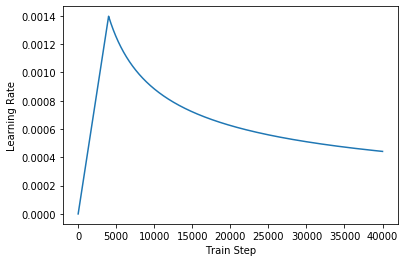
损失函数与指标(Loss and metrics)由于目标序列是填充(padded)过的,因此在计算损失函数时,应用填充遮挡非常重要。
loss_object = tf.keras.losses.SparseCategoricalCrossentropy(from_logits=True, reduction='none')
def loss_function(real, pred): mask = tf.math.logical_not(tf.math.equal(real, 0)) loss_ = loss_object(real, pred)
mask = tf.cast(mask, dtype=loss_.dtype) loss_ *= mask
return tf.reduce_mean(loss_)train_loss = tf.keras.metrics.Mean(name='train_loss')train_accuracy = tf.keras.metrics.SparseCategoricalAccuracy(name='train_accuracy')
训练与检查点(Training and checkpointing)
transformer = Transformer(num_layers, d_model, num_heads, dff, input_vocab_size, target_vocab_size, pe_input=input_vocab_size, pe_target=target_vocab_size, rate=dropout_rate)def create_masks(inp, tar): # 编码器填充遮挡 enc_padding_mask = create_padding_mask(inp)
# 在解码器的第二个注意力模块使用。 # 该填充遮挡用于遮挡编码器的输出。 dec_padding_mask = create_padding_mask(inp)
# 在解码器的第一个注意力模块使用。 # 用于填充(pad)和遮挡(mask)解码器获取到的输入的后续标记(future tokens)。 look_ahead_mask = create_look_ahead_mask(tf.shape(tar)[1]) dec_target_padding_mask = create_padding_mask(tar) combined_mask = tf.maximum(dec_target_padding_mask, look_ahead_mask)
return enc_padding_mask, combined_mask, dec_padding_mask
# 创建检查点的路径和检查点管理器(manager)。这将用于在每 n 个周期(epochs)保存检查点。checkpoint_path = "./checkpoints/train"
ckpt = tf.train.Checkpoint(transformer=transformer,optimizer=optimizer)
ckpt_manager = tf.train.CheckpointManager(ckpt, checkpoint_path, max_to_keep=5)
# 如果检查点存在,则恢复最新的检查点。if ckpt_manager.latest_checkpoint: ckpt.restore(ckpt_manager.latest_checkpoint) print ('Latest checkpoint restored!!')
目标(target)被分成了 tar_inp 和 tar_real。tar_inp 作为输入传递到解码器。tar_real 是位移了 1 的同一个输入:在 tar_inp 中的每个位置,tar_real 包含了应该被预测到的下一个标记(token)。
例如,sentence = "SOS A lion in the jungle is sleeping EOS"
tar_inp = "SOS A lion in the jungle is sleeping"
tar_real = "A lion in the jungle is sleeping EOS"
Transformer 是一个自回归(auto-regressive)模型:它一次作一个部分的预测,然后使用到目前为止的自身的输出来决定下一步要做什么。
在训练过程中,本示例使用了 teacher-forcing 的方法(就像文本生成教程中一样)。无论模型在当前时间步骤下预测出什么,teacher-forcing 方法都会将真实的输出传递到下一个时间步骤上。
当 transformer 预测每个词时,自注意力(self-attention)功能使它能够查看输入序列中前面的单词,从而更好地预测下一个单词。
为了防止模型在期望的输出上达到峰值,模型使用了前瞻遮挡(look-ahead mask)。
EPOCHS = 20# 该 @tf.function 将追踪-编译 train_step 到 TF 图中,以便更快地# 执行。该函数专用于参数张量的精确形状。为了避免由于可变序列长度或可变# 批次大小(最后一批次较小)导致的再追踪,使用 input_signature 指定# 更多的通用形状。
train_step_signature = [ tf.TensorSpec(shape=(None, None), dtype=tf.int64), tf.TensorSpec(shape=(None, None), dtype=tf.int64),]
@tf.function(input_signature=train_step_signature)def train_step(inp, tar): tar_inp = tar[:, :-1] tar_real = tar[:, 1:]
enc_padding_mask, combined_mask, dec_padding_mask = create_masks(inp, tar_inp)
with tf.GradientTape() as tape: predictions, _ = transformer(inp, tar_inp, True, enc_padding_mask, combined_mask, dec_padding_mask) loss = loss_function(tar_real, predictions)
gradients = tape.gradient(loss, transformer.trainable_variables) optimizer.apply_gradients(zip(gradients, transformer.trainable_variables))
train_loss(loss) train_accuracy(tar_real, predictions)
葡萄牙语作为输入语言,英语为目标语言
for epoch in range(EPOCHS): start = time.time()
train_loss.reset_states() train_accuracy.reset_states()
# inp -> portuguese, tar -> english for (batch, (inp, tar)) in enumerate(train_dataset): train_step(inp, tar)
if batch % 50 == 0: print ('Epoch {} Batch {} Loss {:.4f} Accuracy {:.4f}'.format(epoch + 1, batch, train_loss.result(), train_accuracy.result()))
if (epoch + 1) % 5 == 0: ckpt_save_path = ckpt_manager.save() print ('Saving checkpoint for epoch {} at {}'.format(epoch+1,ckpt_save_path))
print ('Epoch {} Loss {:.4f} Accuracy {:.4f}'.format(epoch + 1, train_loss.result(), train_accuracy.result()))
print ('Time taken for 1 epoch: {} secs\n'.format(time.time() - start))
Output:
Epoch 1 Batch 0 Loss 0.2771 Accuracy 0.4265Epoch 1 Batch 50 Loss 0.2988 Accuracy 0.3804Epoch 1 Batch 100 Loss 0.3013 Accuracy 0.3820Epoch 1 Batch 150 Loss 0.3064 Accuracy 0.3844Epoch 1 Batch 200 Loss 0.3108 Accuracy 0.3844Epoch 1 Batch 250 Loss 0.3136 Accuracy 0.3835Epoch 1 Batch 300 Loss 0.3158 Accuracy 0.3831Epoch 1 Batch 350 Loss 0.3184 Accuracy 0.3833Epoch 1 Batch 400 Loss 0.3217 Accuracy 0.3833Epoch 1 Batch 450 Loss 0.3245 Accuracy 0.3835Epoch 1 Batch 500 Loss 0.3267 Accuracy 0.3835Epoch 1 Batch 550 Loss 0.3288 Accuracy 0.3829Epoch 1 Batch 600 Loss 0.3317 Accuracy 0.3830Epoch 1 Batch 650 Loss 0.3348 Accuracy 0.3831Epoch 1 Batch 700 Loss 0.3368 Accuracy 0.3831Epoch 1 Loss 0.3369 Accuracy 0.3830Time taken for 1 epoch: 837.5033097267151 secs
Epoch 2 Batch 0 Loss 0.3254 Accuracy 0.4145Epoch 2 Batch 50 Loss 0.2883 Accuracy 0.3898Epoch 2 Batch 100 Loss 0.2977 Accuracy 0.3925Epoch 2 Batch 150 Loss 0.3007 Accuracy 0.3890Epoch 2 Batch 200 Loss 0.3046 Accuracy 0.3876Epoch 2 Batch 250 Loss 0.3085 Accuracy 0.3863Epoch 2 Batch 300 Loss 0.3115 Accuracy 0.3865Epoch 2 Batch 350 Loss 0.3148 Accuracy 0.3861Epoch 2 Batch 400 Loss 0.3175 Accuracy 0.3865Epoch 2 Batch 450 Loss 0.3204 Accuracy 0.3862Epoch 2 Batch 500 Loss 0.3235 Accuracy 0.3859Epoch 2 Batch 550 Loss 0.3256 Accuracy 0.3854Epoch 2 Batch 600 Loss 0.3281 Accuracy 0.3847Epoch 2 Batch 650 Loss 0.3300 Accuracy 0.3843Epoch 2 Batch 700 Loss 0.3321 Accuracy 0.3842Epoch 2 Loss 0.3322 Accuracy 0.3841Time taken for 1 epoch: 837.3874278068542 secs
Epoch 3 Batch 0 Loss 0.3313 Accuracy 0.4124Epoch 3 Batch 50 Loss 0.2948 Accuracy 0.3916Epoch 3 Batch 100 Loss 0.2949 Accuracy 0.3898Epoch 3 Batch 150 Loss 0.3016 Accuracy 0.3910Epoch 3 Batch 200 Loss 0.3029 Accuracy 0.3912Epoch 3 Batch 250 Loss 0.3038 Accuracy 0.3890Epoch 3 Batch 300 Loss 0.3069 Accuracy 0.3891Epoch 3 Batch 350 Loss 0.3097 Accuracy 0.3886Epoch 3 Batch 400 Loss 0.3116 Accuracy 0.3878Epoch 3 Batch 450 Loss 0.3142 Accuracy 0.3874Epoch 3 Batch 500 Loss 0.3165 Accuracy 0.3870Epoch 3 Batch 550 Loss 0.3185 Accuracy 0.3867Epoch 3 Batch 600 Loss 0.3208 Accuracy 0.3863Epoch 3 Batch 650 Loss 0.3230 Accuracy 0.3857Epoch 3 Batch 700 Loss 0.3259 Accuracy 0.3857Epoch 3 Loss 0.3259 Accuracy 0.3857Time taken for 1 epoch: 840.7752561569214 secs
Epoch 4 Batch 0 Loss 0.2586 Accuracy 0.4231Epoch 4 Batch 50 Loss 0.2878 Accuracy 0.3933Epoch 4 Batch 100 Loss 0.2916 Accuracy 0.3928Epoch 4 Batch 150 Loss 0.2972 Accuracy 0.3931Epoch 4 Batch 200 Loss 0.2995 Accuracy 0.3905Epoch 4 Batch 250 Loss 0.3018 Accuracy 0.3910Epoch 4 Batch 300 Loss 0.3050 Accuracy 0.3907Epoch 4 Batch 350 Loss 0.3073 Accuracy 0.3907Epoch 4 Batch 400 Loss 0.3092 Accuracy 0.3907Epoch 4 Batch 450 Loss 0.3103 Accuracy 0.3897Epoch 4 Batch 500 Loss 0.3114 Accuracy 0.3889Epoch 4 Batch 550 Loss 0.3145 Accuracy 0.3882Epoch 4 Batch 600 Loss 0.3173 Accuracy 0.3882Epoch 4 Batch 650 Loss 0.3187 Accuracy 0.3872Epoch 4 Batch 700 Loss 0.3209 Accuracy 0.3865Epoch 4 Loss 0.3209 Accuracy 0.3865Time taken for 1 epoch: 841.4032762050629 secs
Epoch 5 Batch 0 Loss 0.2532 Accuracy 0.4337Epoch 5 Batch 50 Loss 0.2822 Accuracy 0.3921Epoch 5 Batch 100 Loss 0.2859 Accuracy 0.3926Epoch 5 Batch 150 Loss 0.2915 Accuracy 0.3910Epoch 5 Batch 200 Loss 0.2936 Accuracy 0.3907Epoch 5 Batch 250 Loss 0.2952 Accuracy 0.3902Epoch 5 Batch 300 Loss 0.2991 Accuracy 0.3903Epoch 5 Batch 350 Loss 0.3015 Accuracy 0.3902Epoch 5 Batch 400 Loss 0.3040 Accuracy 0.3897Epoch 5 Batch 450 Loss 0.3066 Accuracy 0.3898Epoch 5 Batch 500 Loss 0.3089 Accuracy 0.3898Epoch 5 Batch 550 Loss 0.3113 Accuracy 0.3897Epoch 5 Batch 600 Loss 0.3137 Accuracy 0.3898Epoch 5 Batch 650 Loss 0.3154 Accuracy 0.3892Epoch 5 Batch 700 Loss 0.3172 Accuracy 0.3883Saving checkpoint for epoch 5 at ./checkpoints/train/ckpt-9Epoch 5 Loss 0.3172 Accuracy 0.3883Time taken for 1 epoch: 836.7346789836884 secs
Epoch 6 Batch 0 Loss 0.2884 Accuracy 0.4005Epoch 6 Batch 50 Loss 0.2729 Accuracy 0.3872Epoch 6 Batch 100 Loss 0.2780 Accuracy 0.3909Epoch 6 Batch 150 Loss 0.2800 Accuracy 0.3895Epoch 6 Batch 200 Loss 0.2827 Accuracy 0.3895Epoch 6 Batch 250 Loss 0.2860 Accuracy 0.3883Epoch 6 Batch 300 Loss 0.2906 Accuracy 0.3886Epoch 6 Batch 350 Loss 0.2938 Accuracy 0.3887Epoch 6 Batch 400 Loss 0.2964 Accuracy 0.3881Epoch 6 Batch 450 Loss 0.2989 Accuracy 0.3884Epoch 6 Batch 500 Loss 0.3017 Accuracy 0.3888Epoch 6 Batch 550 Loss 0.3044 Accuracy 0.3887Epoch 6 Batch 600 Loss 0.3066 Accuracy 0.3881Epoch 6 Batch 650 Loss 0.3090 Accuracy 0.3876Epoch 6 Batch 700 Loss 0.3115 Accuracy 0.3873Epoch 6 Loss 0.3116 Accuracy 0.3873Time taken for 1 epoch: 838.8425750732422 secs
Epoch 7 Batch 0 Loss 0.2667 Accuracy 0.4269Epoch 7 Batch 50 Loss 0.2697 Accuracy 0.3944Epoch 7 Batch 100 Loss 0.2749 Accuracy 0.3937Epoch 7 Batch 150 Loss 0.2792 Accuracy 0.3933Epoch 7 Batch 200 Loss 0.2845 Accuracy 0.3947Epoch 7 Batch 250 Loss 0.2876 Accuracy 0.3944Epoch 7 Batch 300 Loss 0.2894 Accuracy 0.3942Epoch 7 Batch 350 Loss 0.2917 Accuracy 0.3928Epoch 7 Batch 400 Loss 0.2940 Accuracy 0.3922Epoch 7 Batch 450 Loss 0.2963 Accuracy 0.3914Epoch 7 Batch 500 Loss 0.2994 Accuracy 0.3914Epoch 7 Batch 550 Loss 0.3008 Accuracy 0.3902Epoch 7 Batch 600 Loss 0.3033 Accuracy 0.3901Epoch 7 Batch 650 Loss 0.3055 Accuracy 0.3899Epoch 7 Batch 700 Loss 0.3076 Accuracy 0.3893Epoch 7 Loss 0.3077 Accuracy 0.3893Time taken for 1 epoch: 837.0950720310211 secs
Epoch 8 Batch 0 Loss 0.2953 Accuracy 0.4106Epoch 8 Batch 50 Loss 0.2771 Accuracy 0.3970Epoch 8 Batch 100 Loss 0.2785 Accuracy 0.3982Epoch 8 Batch 150 Loss 0.2803 Accuracy 0.3957Epoch 8 Batch 200 Loss 0.2821 Accuracy 0.3946Epoch 8 Batch 250 Loss 0.2834 Accuracy 0.3939Epoch 8 Batch 300 Loss 0.2872 Accuracy 0.3944Epoch 8 Batch 350 Loss 0.2902 Accuracy 0.3943Epoch 8 Batch 400 Loss 0.2913 Accuracy 0.3933Epoch 8 Batch 450 Loss 0.2928 Accuracy 0.3931Epoch 8 Batch 500 Loss 0.2956 Accuracy 0.3934Epoch 8 Batch 550 Loss 0.2975 Accuracy 0.3928Epoch 8 Batch 600 Loss 0.2992 Accuracy 0.3920Epoch 8 Batch 650 Loss 0.3011 Accuracy 0.3917Epoch 8 Batch 700 Loss 0.3032 Accuracy 0.3908Epoch 8 Loss 0.3034 Accuracy 0.3908Time taken for 1 epoch: 836.5397372245789 secs
Epoch 9 Batch 0 Loss 0.2577 Accuracy 0.4107Epoch 9 Batch 50 Loss 0.2686 Accuracy 0.3992Epoch 9 Batch 100 Loss 0.2720 Accuracy 0.3956Epoch 9 Batch 150 Loss 0.2751 Accuracy 0.3961Epoch 9 Batch 200 Loss 0.2776 Accuracy 0.3971Epoch 9 Batch 250 Loss 0.2796 Accuracy 0.3960Epoch 9 Batch 300 Loss 0.2819 Accuracy 0.3955Epoch 9 Batch 350 Loss 0.2842 Accuracy 0.3950Epoch 9 Batch 400 Loss 0.2871 Accuracy 0.3950Epoch 9 Batch 450 Loss 0.2889 Accuracy 0.3947Epoch 9 Batch 500 Loss 0.2914 Accuracy 0.3948Epoch 9 Batch 550 Loss 0.2935 Accuracy 0.3945Epoch 9 Batch 600 Loss 0.2952 Accuracy 0.3937Epoch 9 Batch 650 Loss 0.2972 Accuracy 0.3928Epoch 9 Batch 700 Loss 0.2992 Accuracy 0.3920Epoch 9 Loss 0.2991 Accuracy 0.3919Time taken for 1 epoch: 836.3204340934753 secs
Epoch 10 Batch 0 Loss 0.2756 Accuracy 0.4359Epoch 10 Batch 50 Loss 0.2647 Accuracy 0.4020Epoch 10 Batch 100 Loss 0.2683 Accuracy 0.3995Epoch 10 Batch 150 Loss 0.2706 Accuracy 0.3976Epoch 10 Batch 200 Loss 0.2720 Accuracy 0.3970Epoch 10 Batch 250 Loss 0.2737 Accuracy 0.3956Epoch 10 Batch 300 Loss 0.2764 Accuracy 0.3950Epoch 10 Batch 350 Loss 0.2782 Accuracy 0.3947Epoch 10 Batch 400 Loss 0.2808 Accuracy 0.3947Epoch 10 Batch 450 Loss 0.2828 Accuracy 0.3943Epoch 10 Batch 500 Loss 0.2855 Accuracy 0.3941Epoch 10 Batch 550 Loss 0.2883 Accuracy 0.3941Epoch 10 Batch 600 Loss 0.2905 Accuracy 0.3935Epoch 10 Batch 650 Loss 0.2921 Accuracy 0.3925Epoch 10 Batch 700 Loss 0.2947 Accuracy 0.3924Saving checkpoint for epoch 10 at ./checkpoints/train/ckpt-10Epoch 10 Loss 0.2948 Accuracy 0.3924Time taken for 1 epoch: 838.1140463352203 secs
Epoch 11 Batch 0 Loss 0.2054 Accuracy 0.3631Epoch 11 Batch 50 Loss 0.2661 Accuracy 0.4077Epoch 11 Batch 100 Loss 0.2647 Accuracy 0.4024Epoch 11 Batch 150 Loss 0.2671 Accuracy 0.3988Epoch 11 Batch 200 Loss 0.2703 Accuracy 0.3996Epoch 11 Batch 250 Loss 0.2722 Accuracy 0.3981Epoch 11 Batch 300 Loss 0.2742 Accuracy 0.3978Epoch 11 Batch 350 Loss 0.2762 Accuracy 0.3964Epoch 11 Batch 400 Loss 0.2793 Accuracy 0.3962Epoch 11 Batch 450 Loss 0.2804 Accuracy 0.3962Epoch 11 Batch 500 Loss 0.2820 Accuracy 0.3953Epoch 11 Batch 550 Loss 0.2850 Accuracy 0.3954Epoch 11 Batch 600 Loss 0.2871 Accuracy 0.3946Epoch 11 Batch 650 Loss 0.2892 Accuracy 0.3939Epoch 11 Batch 700 Loss 0.2910 Accuracy 0.3935Epoch 11 Loss 0.2911 Accuracy 0.3934Time taken for 1 epoch: 836.5090510845184 secs
Epoch 12 Batch 0 Loss 0.2596 Accuracy 0.3818Epoch 12 Batch 50 Loss 0.2550 Accuracy 0.3932Epoch 12 Batch 100 Loss 0.2594 Accuracy 0.3966Epoch 12 Batch 150 Loss 0.2616 Accuracy 0.3954Epoch 12 Batch 200 Loss 0.2649 Accuracy 0.3951Epoch 12 Batch 250 Loss 0.2688 Accuracy 0.3957Epoch 12 Batch 300 Loss 0.2704 Accuracy 0.3960Epoch 12 Batch 350 Loss 0.2734 Accuracy 0.3961Epoch 12 Batch 400 Loss 0.2754 Accuracy 0.3957Epoch 12 Batch 450 Loss 0.2779 Accuracy 0.3956Epoch 12 Batch 500 Loss 0.2799 Accuracy 0.3952Epoch 12 Batch 550 Loss 0.2813 Accuracy 0.3945Epoch 12 Batch 600 Loss 0.2836 Accuracy 0.3944Epoch 12 Batch 650 Loss 0.2863 Accuracy 0.3945Epoch 12 Batch 700 Loss 0.2880 Accuracy 0.3940Epoch 12 Loss 0.2880 Accuracy 0.3940Time taken for 1 epoch: 835.4420788288116 secs
Epoch 13 Batch 0 Loss 0.2850 Accuracy 0.4202Epoch 13 Batch 50 Loss 0.2511 Accuracy 0.4039Epoch 13 Batch 100 Loss 0.2531 Accuracy 0.3988Epoch 13 Batch 150 Loss 0.2586 Accuracy 0.3981Epoch 13 Batch 200 Loss 0.2610 Accuracy 0.3965Epoch 13 Batch 250 Loss 0.2639 Accuracy 0.3975Epoch 13 Batch 300 Loss 0.2671 Accuracy 0.3971Epoch 13 Batch 350 Loss 0.2692 Accuracy 0.3974Epoch 13 Batch 400 Loss 0.2715 Accuracy 0.3968Epoch 13 Batch 450 Loss 0.2733 Accuracy 0.3962Epoch 13 Batch 500 Loss 0.2757 Accuracy 0.3963Epoch 13 Batch 550 Loss 0.2778 Accuracy 0.3962Epoch 13 Batch 600 Loss 0.2798 Accuracy 0.3960Epoch 13 Batch 650 Loss 0.2820 Accuracy 0.3957Epoch 13 Batch 700 Loss 0.2838 Accuracy 0.3951Epoch 13 Loss 0.2838 Accuracy 0.3950Time taken for 1 epoch: 834.2117850780487 secs
Epoch 14 Batch 0 Loss 0.2444 Accuracy 0.4170Epoch 14 Batch 50 Loss 0.2541 Accuracy 0.4027Epoch 14 Batch 100 Loss 0.2541 Accuracy 0.3988Epoch 14 Batch 150 Loss 0.2576 Accuracy 0.4016Epoch 14 Batch 200 Loss 0.2616 Accuracy 0.4000Epoch 14 Batch 250 Loss 0.2624 Accuracy 0.3992Epoch 14 Batch 300 Loss 0.2647 Accuracy 0.3986Epoch 14 Batch 350 Loss 0.2675 Accuracy 0.3983Epoch 14 Batch 400 Loss 0.2688 Accuracy 0.3980Epoch 14 Batch 450 Loss 0.2705 Accuracy 0.3976Epoch 14 Batch 500 Loss 0.2725 Accuracy 0.3973Epoch 14 Batch 550 Loss 0.2745 Accuracy 0.3970Epoch 14 Batch 600 Loss 0.2767 Accuracy 0.3968Epoch 14 Batch 650 Loss 0.2789 Accuracy 0.3961Epoch 14 Batch 700 Loss 0.2811 Accuracy 0.3960Epoch 14 Loss 0.2811 Accuracy 0.3960Time taken for 1 epoch: 840.4115641117096 secs
Epoch 15 Batch 0 Loss 0.2785 Accuracy 0.3988Epoch 15 Batch 50 Loss 0.2486 Accuracy 0.4043Epoch 15 Batch 100 Loss 0.2527 Accuracy 0.4026Epoch 15 Batch 150 Loss 0.2571 Accuracy 0.4022Epoch 15 Batch 200 Loss 0.2567 Accuracy 0.3995Epoch 15 Batch 250 Loss 0.2592 Accuracy 0.3999Epoch 15 Batch 300 Loss 0.2615 Accuracy 0.4000Epoch 15 Batch 350 Loss 0.2637 Accuracy 0.3998Epoch 15 Batch 400 Loss 0.2643 Accuracy 0.3989Epoch 15 Batch 450 Loss 0.2661 Accuracy 0.3982Epoch 15 Batch 500 Loss 0.2682 Accuracy 0.3971Epoch 15 Batch 550 Loss 0.2701 Accuracy 0.3969Epoch 15 Batch 600 Loss 0.2725 Accuracy 0.3968Epoch 15 Batch 650 Loss 0.2751 Accuracy 0.3962Epoch 15 Batch 700 Loss 0.2777 Accuracy 0.3964Saving checkpoint for epoch 15 at ./checkpoints/train/ckpt-11Epoch 15 Loss 0.2777 Accuracy 0.3964Time taken for 1 epoch: 836.3041331768036 secs
Epoch 16 Batch 0 Loss 0.2658 Accuracy 0.4402Epoch 16 Batch 50 Loss 0.2486 Accuracy 0.4023Epoch 16 Batch 100 Loss 0.2487 Accuracy 0.4023Epoch 16 Batch 150 Loss 0.2513 Accuracy 0.4028Epoch 16 Batch 200 Loss 0.2527 Accuracy 0.4017Epoch 16 Batch 250 Loss 0.2547 Accuracy 0.4019Epoch 16 Batch 300 Loss 0.2576 Accuracy 0.4020Epoch 16 Batch 350 Loss 0.2606 Accuracy 0.4020Epoch 16 Batch 400 Loss 0.2622 Accuracy 0.4006Epoch 16 Batch 450 Loss 0.2637 Accuracy 0.3992Epoch 16 Batch 500 Loss 0.2654 Accuracy 0.3987Epoch 16 Batch 550 Loss 0.2675 Accuracy 0.3987Epoch 16 Batch 600 Loss 0.2697 Accuracy 0.3989Epoch 16 Batch 650 Loss 0.2718 Accuracy 0.3988Epoch 16 Batch 700 Loss 0.2738 Accuracy 0.3983Epoch 16 Loss 0.2741 Accuracy 0.3983Time taken for 1 epoch: 834.1861200332642 secs
Epoch 17 Batch 0 Loss 0.1989 Accuracy 0.3878Epoch 17 Batch 50 Loss 0.2413 Accuracy 0.4070Epoch 17 Batch 100 Loss 0.2439 Accuracy 0.4038Epoch 17 Batch 150 Loss 0.2469 Accuracy 0.4022Epoch 17 Batch 200 Loss 0.2501 Accuracy 0.4024Epoch 17 Batch 250 Loss 0.2516 Accuracy 0.4007Epoch 17 Batch 300 Loss 0.2536 Accuracy 0.4007Epoch 17 Batch 350 Loss 0.2562 Accuracy 0.4003Epoch 17 Batch 400 Loss 0.2588 Accuracy 0.4001Epoch 17 Batch 450 Loss 0.2606 Accuracy 0.3994Epoch 17 Batch 500 Loss 0.2620 Accuracy 0.3993Epoch 17 Batch 550 Loss 0.2641 Accuracy 0.3988Epoch 17 Batch 600 Loss 0.2657 Accuracy 0.3982Epoch 17 Batch 650 Loss 0.2679 Accuracy 0.3980Epoch 17 Batch 700 Loss 0.2700 Accuracy 0.3977Epoch 17 Loss 0.2702 Accuracy 0.3978Time taken for 1 epoch: 835.0433349609375 secs
Epoch 18 Batch 0 Loss 0.2166 Accuracy 0.4062Epoch 18 Batch 50 Loss 0.2412 Accuracy 0.4051Epoch 18 Batch 100 Loss 0.2425 Accuracy 0.4041Epoch 18 Batch 150 Loss 0.2451 Accuracy 0.4022Epoch 18 Batch 200 Loss 0.2479 Accuracy 0.4030Epoch 18 Batch 250 Loss 0.2504 Accuracy 0.4023Epoch 18 Batch 300 Loss 0.2532 Accuracy 0.4019Epoch 18 Batch 350 Loss 0.2544 Accuracy 0.4009Epoch 18 Batch 400 Loss 0.2555 Accuracy 0.4009Epoch 18 Batch 450 Loss 0.2565 Accuracy 0.4000Epoch 18 Batch 500 Loss 0.2590 Accuracy 0.3996Epoch 18 Batch 550 Loss 0.2612 Accuracy 0.3996Epoch 18 Batch 600 Loss 0.2636 Accuracy 0.3991Epoch 18 Batch 650 Loss 0.2653 Accuracy 0.3986Epoch 18 Batch 700 Loss 0.2671 Accuracy 0.3982Epoch 18 Loss 0.2672 Accuracy 0.3981Time taken for 1 epoch: 836.7380259037018 secs
Epoch 19 Batch 0 Loss 0.1827 Accuracy 0.3199Epoch 19 Batch 50 Loss 0.2371 Accuracy 0.4088Epoch 19 Batch 100 Loss 0.2367 Accuracy 0.4053Epoch 19 Batch 150 Loss 0.2392 Accuracy 0.4017Epoch 19 Batch 200 Loss 0.2416 Accuracy 0.4018Epoch 19 Batch 250 Loss 0.2446 Accuracy 0.4023Epoch 19 Batch 300 Loss 0.2470 Accuracy 0.4023Epoch 19 Batch 350 Loss 0.2496 Accuracy 0.4013Epoch 19 Batch 400 Loss 0.2515 Accuracy 0.4014Epoch 19 Batch 450 Loss 0.2535 Accuracy 0.4010Epoch 19 Batch 500 Loss 0.2560 Accuracy 0.4007Epoch 19 Batch 550 Loss 0.2584 Accuracy 0.4008Epoch 19 Batch 600 Loss 0.2598 Accuracy 0.4000Epoch 19 Batch 650 Loss 0.2621 Accuracy 0.3993Epoch 19 Batch 700 Loss 0.2640 Accuracy 0.3991Epoch 19 Loss 0.2641 Accuracy 0.3991Time taken for 1 epoch: 838.4264571666718 secs
Epoch 20 Batch 0 Loss 0.2607 Accuracy 0.3957Epoch 20 Batch 50 Loss 0.2378 Accuracy 0.4036Epoch 20 Batch 100 Loss 0.2369 Accuracy 0.4022Epoch 20 Batch 150 Loss 0.2393 Accuracy 0.4031Epoch 20 Batch 200 Loss 0.2416 Accuracy 0.4030Epoch 20 Batch 250 Loss 0.2420 Accuracy 0.4019Epoch 20 Batch 300 Loss 0.2442 Accuracy 0.4018Epoch 20 Batch 350 Loss 0.2467 Accuracy 0.4029Epoch 20 Batch 400 Loss 0.2497 Accuracy 0.4030Epoch 20 Batch 450 Loss 0.2506 Accuracy 0.4020Epoch 20 Batch 500 Loss 0.2525 Accuracy 0.4014Epoch 20 Batch 550 Loss 0.2545 Accuracy 0.4008Epoch 20 Batch 600 Loss 0.2575 Accuracy 0.4007Epoch 20 Batch 650 Loss 0.2598 Accuracy 0.4005Epoch 20 Batch 700 Loss 0.2615 Accuracy 0.3997Saving checkpoint for epoch 20 at ./checkpoints/train/ckpt-12Epoch 20 Loss 0.2615 Accuracy 0.3996Time taken for 1 epoch: 841.6034660339355 secs
评估(Evaluate) 以下步骤用于评估:
用葡萄牙语分词器(tokenizer_pt)编码输入语句。此外,添加开始和结束标记,这样输入就与模型训练的内容相同。这是编码器输入。解码器输入为 start token == tokenizer_en.vocab_size。计算填充遮挡和前瞻遮挡。解码器通过查看编码器输出和它自身的输出(自注意力)给出预测。选择最后一个词并计算它的 argmax。将预测的词连接到解码器输入,然后传递给解码器。在这种方法中,解码器根据它预测的之前的词预测下一个。Note:这里使用的模型具有较小的能力以保持相对较快,因此预测可能不太正确。要复现论文中的结果,请使用全部数据集,并通过修改上述超参数来使用基础 transformer 模型或者 transformer XL。
def evaluate(inp_sentence): start_token = [tokenizer_pt.vocab_size] end_token = [tokenizer_pt.vocab_size + 1]
# 输入语句是葡萄牙语,增加开始和结束标记 inp_sentence = start_token + tokenizer_pt.encode(inp_sentence) + end_token encoder_input = tf.expand_dims(inp_sentence, 0)
# 因为目标是英语,输入 transformer 的第一个词应该是 # 英语的开始标记。 decoder_input = [tokenizer_en.vocab_size] output = tf.expand_dims(decoder_input, 0)
for i in range(MAX_LENGTH): enc_padding_mask, combined_mask, dec_padding_mask = create_masks(encoder_input, output)
# predictions.shape == (batch_size, seq_len, vocab_size) predictions, attention_weights = transformer(encoder_input, output, False, enc_padding_mask, combined_mask, dec_padding_mask)
# 从 seq_len 维度选择最后一个词 predictions = predictions[: ,-1:, :] # (batch_size, 1, vocab_size)
predicted_id = tf.cast(tf.argmax(predictions, axis=-1), tf.int32)
# 如果 predicted_id 等于结束标记,就返回结果 if predicted_id == tokenizer_en.vocab_size+1: return tf.squeeze(output, axis=0), attention_weights
# 连接 predicted_id 与输出,作为解码器的输入传递到解码器。 output = tf.concat([output, predicted_id], axis=-1)
return tf.squeeze(output, axis=0), attention_weights
def plot_attention_weights(attention, sentence, result, layer): fig = plt.figure(figsize=(16, 8))
sentence = tokenizer_pt.encode(sentence)
attention = tf.squeeze(attention[layer], axis=0)
for head in range(attention.shape[0]): ax = fig.add_subplot(2, 4, head+1)
# 画出注意力权重 ax.matshow(attention[head][:-1, :], cmap='viridis')
fontdict = {'fontsize': 10}
ax.set_xticks(range(len(sentence)+2)) ax.set_yticks(range(len(result)))
ax.set_ylim(len(result)-1.5, -0.5)
ax.set_xticklabels(['<start>']+[tokenizer_pt.decode([i]) for i in sentence]+['<end>'], fontdict=fontdict, rotation=90)
ax.set_yticklabels([tokenizer_en.decode([i]) for i in result if i < tokenizer_en.vocab_size], fontdict=fontdict)
ax.set_xlabel('Head {}'.format(head+1))
plt.tight_layout() plt.show() def translate(sentence, plot=''): result, attention_weights = evaluate(sentence)
predicted_sentence = tokenizer_en.decode([i for i in result if i < tokenizer_en.vocab_size])
print('Input: {}'.format(sentence)) print('Predicted translation: {}'.format(predicted_sentence))
if plot: plot_attention_weights(attention_weights, sentence, result, plot)
实践翻译:
translate("este é um problema que temos que resolver.")print ("Real translation: this is a problem we have to solve .")
translate("os meus vizinhos ouviram sobre esta ideia.")print ("Real translation: and my neighboring homes heard about this idea .")
translate("vou então muito rapidamente partilhar convosco algumas histórias de algumas coisas mágicas que aconteceram.")print ("Real translation: so i 'll just share with you some stories very quickly of some magical things that have happened .")
输出:Input: este é um problema que temos que resolver.Predicted translation: so this is a problem that we have to solve ...c . to fix .Real translation: this is a problem we have to solve .Input: os meus vizinhos ouviram sobre esta ideia.Predicted translation: my neighbors heard about this idea of an idea .Real translation: and my neighboring homes heard about this idea .Input: vou então muito rapidamente partilhar convosco algumas histórias de algumas coisas mágicas que aconteceram.Predicted translation: so i 'm going to spend a few of you could share with you a few really magic stories that happen .Real translation: so i 'll just share with you some stories very quickly of some magical things that have happened .
AI_robot
还未添加个人签名 2021.03.31 加入
Deep Learning从业者












评论